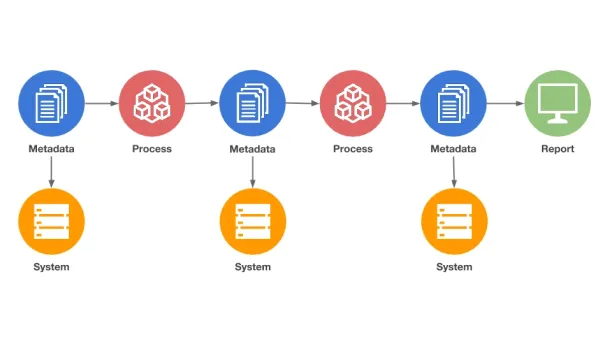Data Lineage: Techniques, Best Practices & Use Cases in 2024
Data and data-driven decision making are critical for business success. To rely on data in decisions, businesses need to understand where the data comes from, how it is processed and transformed. However, tracking the flow of data from source to destination can be complex.
Data lineage provides a map of the data journey within business systems to improve a business’ understanding of the quality of its data. Data-driven businesses need to incorporate data lineage best practices & tools to ensure that their data-driven decisions are accurate.
What is data lineage?
Data lineage is the process of identifying the pathway from the origin of data to its current location. It records how data is processed, transformed, and transmitted. It helps organizations get an overview of data movement over time and track data dynamics by displaying the history of data, as illustrated below.

Why is data lineage important?
Data lineage allows businesses to see how datasets are used and what changes have been made. This visibility helps businesses understand and correct the source of error. It provides better data quality, and companies can solve problems in existing applications faster and create new applications more easily.
What are the techniques of data lineage?
- Lineage by parsing: It automatically reads the logic used to process data. Capturing changes across systems is easy with this form of data lineage since it tracks data as it moves. However, it requires a high level of understanding of the programming languages or tools used throughout the data lifecycle.
- Lineage by data tagging: Transformation engine tags data that transforms or moves. Then it tracks the tag from start to finish to produce a lineage representation. However, it only works if you have a consistent transformation tool to control all data movement.
- Pattern-based lineage: It uses patterns to perform lineage instead of dealing with the code that transforms the data. It relies on metadata to create a lineage by looking for patterns. The main advantage of this technique is that only looking at the data, unlike data lineage by parsing technique, pattern based lineage doesn’t need to understand any programming language to process data. It monitors the data, not the algorithms.
What are the best practices for data lineage?
- Automation: Manually tracking and recording the lineage is not feasible. In order to compete in the fast-paced business environment, you need to automate the process.
- Review of metadata sources: The owners of the data lineage applications and tools should be able to verify the respective metadata sources and identify the causes of errors and bugs in the data sets.
- Progressive extraction: Extracting metadata and lineage consecutively organizes the metadata log and reduces errors when reading the data.
- Including different metadata sources: Metadata generated by various data generation processes should be included in the data lineage to be tracked.
What are the use cases for data lineage?
- Improving data quality:
- Identifying data quality issues: Data constantly changes and new data collection methods need to be incorporated. Data lineage provides detailed information about the location and lifecycle of data sources by tracking them from the source to their current location. It allows businesses to evaluate trustworthiness of data sources and determine if the data has been transformed correctly.
- Detecting the root cause of errors: Data lineage identifies incorrect assumptions about data and provides a reasonable explanation for each error present. Teams can understand and correct sources of errors.
- DataOps: Better data understanding helps increase the efficiency of data operations and avoid errors
- Impact analysis: Data lineage allows businesses to see which users interact with data and how they will be affected after a change is made. It measures the impact of data and informs about who or what will be affected by the change.
- System upgrades: Data lineage enables data teams to understand which data sources are obsolete, non-existent or which datasets are relevant. This reduces the amount of non-relevant data stored and managed. It enables organizations to implement upgrading and migration projects faster.
- Data migrations: When IT teams need to move data to new storage or new systems, data lineage provides them with details about how the data has been sourced and stored. It reduces the risk of migration projects.
- Data governance: Data lineage provides transparency over the life cycle of data
- audit trails for data management
- identification of areas of potential risk
What are the differences between data lineage and data provenance?
Data lineage and data provenance generally document the flow of data and the tracking of data changes. Data lineage is a more specific term and is defined as the life cycle of data elements. It includes the origin of data and changes on it from source to destination. Data provenance captures inputs, entities, systems, and processes. It documents the processes that affect the data of interest.
Recommendations / Next Steps
Data-driven decision-making is critical for enterprises and data lineage enables this by improving data quality and data understanding. We recommend data and technology leaders explore data lineage solutions. If you have questions about which solutions to choose, we are happy to help:



Comments
Your email address will not be published. All fields are required.